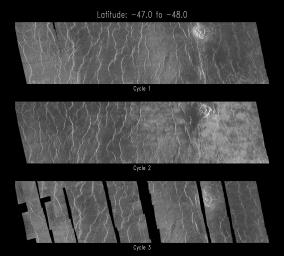- Original Caption Released with Image:
-
This set of three Magellan images shows a small volcano, lava plains distorted into 'wrinkle ridges', and some unusual wispy-appearing surface deposits. The images were acquired during the first, second and third mapping cycles of the mission, in March 1991, November 1991 and July 1992, respectively. The area shown is about 400 kilometers by 100 kilometers (248 by 62 miles) and is centered near 47.5 degrees south latitude, 226 degrees east longitude, in the Imdr region of Venus. The middle image, from the second cycle, was acquired with the spacecraft facing toward the west (left), while the other images were acquired with an identical east-looking geometry. The differing appearance of the second image has intrigued Magellan scientists, because of the possibility that the bright patches observed in cycle 2 may have been caused by rearrangement of loose soil material between March and November, 1991. However, by duplicating the cycle 1 viewing geometry in cycle 3, the surface change theory has been tentatively ruled out. Instead, the radar brightness variations are attributed to reflections from an undulating surface, such as sand ripples or small dunes, that have an asymmetry in the east-west direction. The deposits are apparently associated with a 78 kilometers (48 miles) diameter impact crater, Stowe, which lies about 500 kilometers (310 miles) to the northeast. The fine-grained material created during the impact event may have settled out to form the unusual surface deposits observed here. Scientists are now trying to determine if the proposed ripple structures formed at the time of the impact, or are the result of ongoing wind action at the surface. Data quality during portions of cycle 3 was adversely affected by a faulty transmitter aboard the spacecraft, leading to the missing strips in the bottom image.
- Image Credit:
-
NASA/JPL
Image Addition Date: -
1996-03-14
|

 Planetary Data System
Planetary Data System












